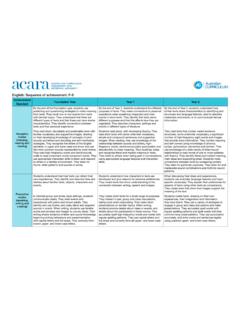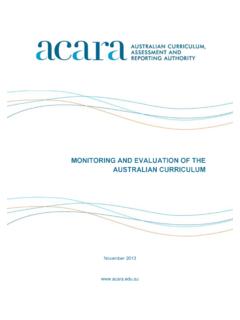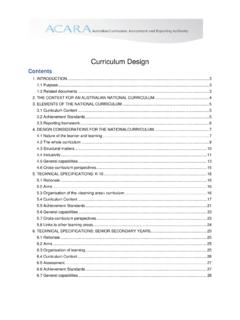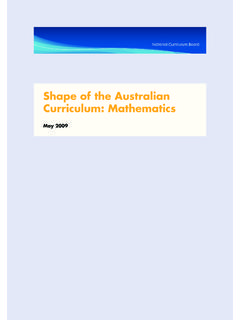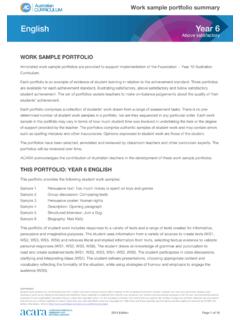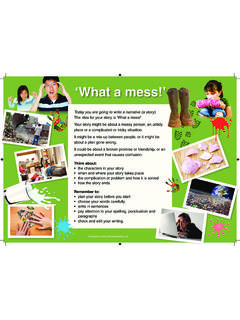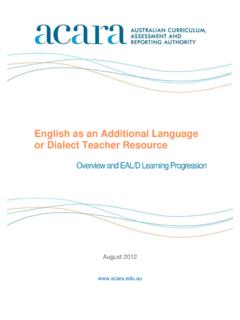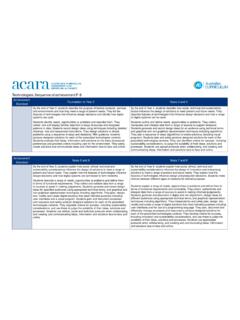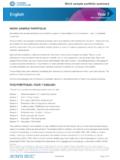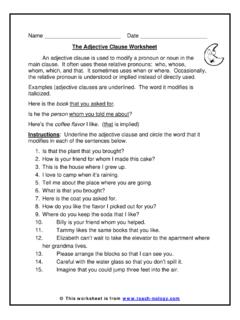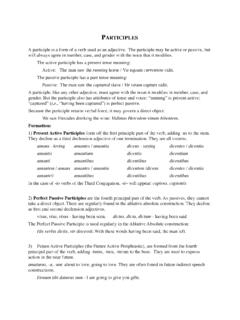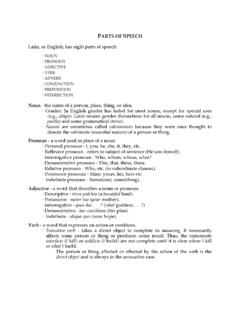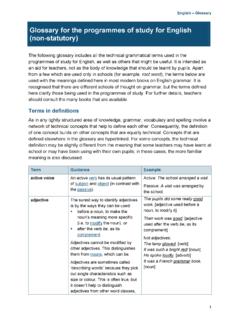Transcription of English: Sequence of content F-6 Strand: Language …
1 english : Sequence of content F-6 Strand: Australian Curriculum December 2015 Page 1 Sub-strandFoundationYear 1 Year 2 Year 3 Year 4 Year 5 Year 6 Language Variation and change sub-strandLanguage variation and changeHow english varies according to context and purpose, including cultural and historical contextUnderstand that english is one of many languages spoken in Australia and that different languages may be spoken by family, classmates and community (ACELA1426)Understand that people use different systems of communication to cater to different needs and purposes and that many people may use sign systems to communicate with others (ACELA1443)Understand that spoken, visual and written forms of Language are different modes of communication with different features and their use varies according to the audience, purpose, context and cultural background (ACELA1460)Understand that languages have different written and visual communication systems, different oral traditions and different ways of constructing meaning (ACELA1475)Understand that Standard Australian english is one of many social dialects used in Australia, and that while it originated in England it has been influenced by many other languages (ACELA1487)Understand that the pronunciation, spelling and meanings of words have histories and change over time (ACELA1500)
2 Understand that different social and geographical dialects or accents are used in Australia in addition to Standard Australian english (ACELA1515) Language for interaction sub-strandLanguage for social interactionsHow Language used for different formal and informal social interactions is influenced by the purpose and audienceExplore how Language is used differently at home and school depending on the relationships between people (ACELA1428)Understand that Language is used in combination with other means of communication, for example facial expressions and gestures to interact with others (ACELA1444) Understand that there are different ways of asking for information, making offers and giving commands (ACELA1446)Understand that Language varies when people take on different roles in social and classroom interactions and how the use of key interpersonal Language resources varies depending on context (ACELA1461)Understand that successful cooperation with others depends on shared use of social conventions, including turn-taking patterns, and forms of address that vary according to the degree of formality in social situations (ACELA1476)Understand that social interactions influence the way people engage with ideas and respond to others for example when exploring and clarifying the ideas of others, summarising their own views and reporting them to a larger group (ACELA1488)
3 Understand that patterns of Language interaction vary across social contexts and types of texts and that they help to signal social roles and relationships (ACELA1501)Understand that strategies for interaction become more complex and demanding as levels of formality and social distance increase (ACELA1516)Sub-strandFoundationYear 1 Year 2 Year 3 Year 4 Year 5 Year 6 Evaluative languageHow Language is used to express opinions and make evaluative judgments about people, places, things and textsUnderstand that Language can be used to explore ways of expressing needs, likes and dislikes (ACELA1429)Explore different ways of expressing emotions, including verbal, visual, body Language and facial expressions (ACELA1787)Identify Language that can be used for appreciating texts and the qualities of people and things (ACELA1462)Examine how evaluative Language can be varied to be more or less forceful (ACELA1477)Understand differences between the Language of opinion and feeling and the Language of factual reporting or recording (ACELA1489)Understand how to move beyond making bare assertions and take account of differing perspectives and points of view (ACELA1502)Understand the uses of objective and subjective Language and bias (ACELA1517)
4 Text structure and organisation sub-strandPurpose audience and structures of different types of textsHow texts serve different purposes and how the structures of types of texts vary according to the text purpose Understand that the purposes texts serve shape their structure in predictable ways (ACELA1447)Understand that different types of texts have identifiable text structures and Language features that help the text serve its purpose (ACELA1463)Understand how different types of texts vary in use of Language choices, depending on their purpose and context (for example, tense and types of sentences) (ACELA1478)Understand how texts vary in complexity and technicality depending on the approach to the topic, the purpose and the intended audience (ACELA1490)Understand how texts vary in purpose, structure and topic as well as the degree of formality (ACELA1504)Understand how authors often innovate on text structures and play with Language features to achieve particular aesthetic, humorous and persuasive purposes and effects (ACELA1518) english : Sequence of content F-6 Strand.
5 Australian Curriculum December 2015 Page 2 Sub-strandFoundationYear 1 Year 2 Year 3 Year 4 Year 5 Year 6 Text cohesionHow texts work as cohesive wholes through Language features that link parts of the text together, such as paragraphs, connectives, nouns and associated pronounsUnderstand that some Language in written texts is unlike everyday spoken Language (ACELA1431)Understand patterns of repetition and contrast in simple texts (ACELA1448)Understand how texts are made cohesive through Language features, including word associations, synonyms, and antonyms (ACELA1464)Understand that paragraphs are a key organisational feature of written texts (ACELA1479)Understand how texts are made cohesive through the use of linking devices including pronoun reference and text connectives (ACELA1491)Understand that the starting point of a sentence gives prominence to the message in the text and allows for prediction of how the text will unfold (ACELA1505)Understand that cohesive links can be made in texts by omitting or replacing words (ACELA1520)PunctuationHow punctuation works to perform different functions in a that punctuation is a feature of written text different from letters.
6 Recognise how capital letters are used for names, and that capital letters and full stops signal the beginning and end of sentences (ACELA1432)Recognise that different types of punctuation, including full stops, question marks and exclamation marks, signal sentences that make statements, ask questions, express emotion or give commands (ACELA1449)Recognise that capital letters signal proper nouns and commas are used to separate items in lists (ACELA1465)Know that word contractions are a feature of informal Language and that apostrophes of contraction are used to signal missing letters (ACELA1480) Recognise how quotation marks are used in texts to signal dialogue, titles and quoted (direct) speech (ACELA1492)Understand how the grammatical category of possessives is signalled through apostrophes and how to use apostrophes with common and proper nouns (ACELA1506)Understand the use of commas to separate clauses (ACELA1521)Concepts of print and screenDifferent conventions that apply to how text is presented on a page or screenUnderstand concepts about print and screen, including how books, film and simple digital texts work, and know some features of print, for example directionality (ACELA1433)Understand concepts about print and screen, including how different types of texts are organised using page numbering, tables of content , headings and titles, navigation buttons, bars and links (ACELA1450)
7 Know some features of text organisation including page and screen layouts, alphabetical order, and different types of diagrams, for example timelines (ACELA1466)Identify the features of online texts that enhance navigation (ACELA1790)Identify features of online texts that enhance readability including text, navigation, links, graphics and layout (ACELA1793)Investigate how the organisation of texts into chapters, headings, subheadings, home pages and sub pages for online texts and according to chronology or topic can be used to predict content and assist navigation (ACELA1797)This Sequence ends at Year 5 english : Sequence of content F-6 Strand: Australian Curriculum December 2015 Page 3 Sub-strandFoundationYear 1 Year 2 Year 3 Year 4 Year 5 Year 6 Expressing and developing ideas sub-strandSentences and clause-level grammarWhat a clause is and how simple, compound and complex sentences are constructed through one clause (simple) or by combining clauses using different types of conjunctions (compound and complex) Recognise that sentences are key units for expressing ideas (ACELA1435)Identify the parts of a simple sentence that represent What is happening?
8 , What state is being described? , Who or what is involved? and the surrounding circumstances (ACELA1451)Understand that simple connections can be made between ideas by using a compound sentence with two or more clauses usually linked by a coordinating conjunction (ACELA1467)Understand that a clause is a unit of grammar usually containing a subject and a verb and that these need to be in agreement (ACELA1481)Understand that the meaning of sentences can be enriched through the use of noun groups/phrases and verb groups/phrases and prepositional phrases (ACELA1493)Investigate how quoted (direct) and reported (indirect) speech work in different types of text (ACELA1494)Understand the difference between main and subordinate clauses and that a complex sentence involves at least one subordinate clause (ACELA1507)
9 Investigate how complex sentences can be used in a variety of ways to elaborate, extend and explain ideas (ACELA1522)Word-level grammarDifferent classes of words used in english (nouns, verbs, etc), the functions they perform in sentences and when they are combined in particular recognisable groups such as phrases and noun groupsRecognise that texts are made up of words and groups of words that make meaning (ACELA1434)Explore differences in words that represent people, places and things (nouns, including pronouns), happenings and states (verbs), qualities (adjectives) and details such as when, where and how (adverbs) (ACELA1452)Understand that nouns represent people, places, concrete objects and abstract concepts; that there are three types of nouns: common, proper and pronouns; and that noun groups/phrases can be expanded using articles and adjectives (ACELA1468)Understand that verbs represent different processes, for example.
10 Doing, thinking, saying, and relating and that these processes are anchored in time through tense (ACELA1482)Understand how adverb groups/phrases and prepositional phrases work in different ways to provide circumstantial details about an activity (ACELA1495)Understand how noun groups/phrases and adjective groups/phrases can be expanded in a variety of ways to provide a fuller description of the person, place, thing or idea (ACELA1508)Understand how ideas can be expanded and sharpened through careful choice of verbs, elaborated tenses and a range of adverb groups/phrases (ACELA1523) english : Sequence of content F-6 Strand: Australian Curriculum December 2015 Page 4 Sub-strandFoundationYear 1 Year 2 Year 3 Year 4 Year 5 Year 6 Visual languageHow images work in texts to communicate meanings, especially in conjunction with other elements such as print and soundExplore the different contribution of words and images to meaning in stories and informative texts (ACELA1786)Compare different kinds of images in narrative and informative texts and discuss how they contribute to meaning (ACELA1453)Identify visual representations of characters actions, reactions, speech and th
